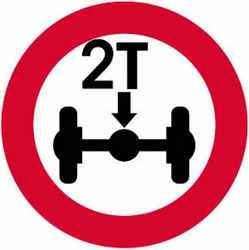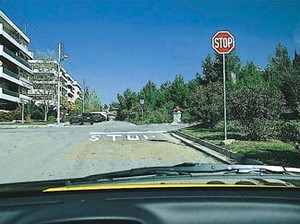QUESTION 1
QUESTION 1
Which vehicles are forbidden to enter a street by this traffic sign?

Vehicles that have a useful load of 2 tons.
Vehicles with a weight of over 2 tons per axle.
Vehicles with a total weight of up to 2 tons.

QUESTION 2
QUESTION 2
What should you do in this case?

Move up to the stop line, stop and, after checking that no vehicles are coming vertically, to which you have to give priority, go on.
Move up to the STOP sign, stop there and give priority to the vehicles coming vertically. As long as you do not see any vehicles coming, cross the intersection.

QUESTION 3
QUESTION 3
Every time you overtake a vehicle at night and you are allowed to turn on the full beam headlights, you should do this:

Before moving to the left.
When you are on the left and before reaching the level of the other vehicle.
When you are at the same level with the other vehicle.

QUESTION 4
QUESTION 4
In which lane(s) of motorways with three or more lanes per direction are lorries or combinations of them permitted to move:

Only in the rightmost lane.
In the two rightmost lanes.
In any lane, depending on the traffic conditions.

QUESTION 5
QUESTION 5
To complete a journey of about 300 km at an average speed of 70km/h, you will need:

5 hours and thirty minutes.
4 hours.
5 hours.

QUESTION 6
QUESTION 6
The maximum weight of a three-axle lorry with a mechanical suspension system that performs international transports, is:

26.000 kg.
25.000 kg.
28.000 kg.

QUESTION 7
QUESTION 7
Articulated vehicle is:

The combination of vehicles that includes a tractive unit and a semi-trailer attached thereto.
The combination of vehicles that includes a lorry and a trailer attached thereto.
The automobile vehicle intended mainly for the transport of objects.

QUESTION 8
QUESTION 8
On both sides of lorries the following should be written:

Lorry’s maximum permissible weight, useful load and main office.
Lorry’s length and distance between the axles.
Lorry’s height and width.

QUESTION 9
QUESTION 9
What is the function of the primary shaft in the gear-box?

Through the clutch it is driven by the engine.
Through the central shaft and the joints, it drives the driving wheels.
It is driven by the central shaft and drives the secondary shaft.

QUESTION 10
QUESTION 10
What does the oil manometer on the dash-board of a lorry show?

Engine oil pressure.
Hydraulic brakes oil pressure.
Sump oil quantity.

RESULTS-
ΕΡ
TR
ΕΠ
RESULTS
SECTION

